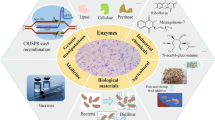Abstract
This novel orange fluorescent protein (OFP) emits brilliant orange fluorescent light. OFP has high fluorescence quantum yield, fast maturation rate, and stability, which imply this protein should be the most favorable biotechnological tools used to investigate the function of target gene by visualizing, monitoring, and quantifying in living cells. B. mori, silkworm has been used as an important bioreactor for the production of recombinant proteins through baculovirus expression system (BES). In this paper, we used infection technique which introduced the baculovirus DNA into silkworms using a cationic lipofectin reagent instead of directly injecting the virus, and demonstrated a high-level expression of the orange fluorescent protein (OFP) gene in the Bombyx mori, silkworm larvae. When recombinant rBacmid/BmNPV/OFP DNA ranging from 50–100 ng/larval was injected, a sufficient OFP expression in hemolymph was harvested. The recombinant viruses could be obtained from the hemolymph of infected larvae and stored as seed which could be used for the large-scale expression. This procedure omitted the costly and labor-consumed insect cell culture. Further investigation of OFP should provide us with more insight in unlocking the mystery of the mechanisms of autocatalytic bioluminescence and its utilization in biotechnology.




Similar content being viewed by others
References
Donglai Wu, Kenji Murakami, Nihong Liu, Yasuo Inoshima, Takashi Yokoyama, Takehiro Kokuho, Shigeki Inumarun (2002) Expression of biologically active recombinant equine interferon-γby two different baculovirus gene expression systems using insect cells and silkworm larvae. Cytokine 20:63–69
Enoch Y Park, Ayano Kageshima, Mi-Sun Kwon, Tatsuya Kato (2007) Enhanced production of secretory β1,3-N-acetylglucosaminyltransferase 2 fusion protein into hemolymph of Bombyx mori larvae using recombinant BmNPV bacmid integrated signal sequence. J Biochem 129:681–688
Shimomura O, Johnson FH, Saiga Y (1962) Extraction, purification and properties of aequorin, a bioluminescent protein from the luminous hydromedusan Aequorea. J Cell Comp Physiol 59:223–239
Morin JG, Hastings JW (1971) Biochemistry of the bioluminescence of colonial hydroids and other coelenterates. J Cell Physiol 77:305–312
Morise H, Shimomura O, Johnson FH, Winant J (1974) Intermolecular energy transfer in the bioluminescent system. Biochemistry 13:2656–2662
Gerdes HH, Kaether C (1996) Green fluorescent protein: applications in cell biology. FEBS Lett 389:44–47
Heim R, Tsien RY (1996) Engineering green fluorescent protein for improved brightness, longer wavelengths and fluorescence resonance energy transfer. Curr Biol 6:178–182
Cubitt AB, Heim R, Adams SR, Boyd AE, Gross LA, Tsien RY (1995) Understanding, improving and using green fluorescent proteins. Trends Biochem Sci 20:448–455
Delagrave S, Hawtin RE, Silva CM, Yang MM, Youvan DC (1995) Red-shifted excitation mutants of the green fluorescent protein. Biotechnology (NY) 13:151–154
Crameri A, Whitehorn EA, Tate E, Stemmer WP (1996) Improved green fluorescent protein by molecular evolution using DNA shuffling. Nat Biotechnol 14:315–319
Matz MV, Fradkov AF, Labas YA, Savitsky AP, Zaraisky AG, Markelov ML, Lukyanov SA (1999) Fluorescent proteins from non-bioluminescent Anthozoa species. Nat Biotechnol 17:969–973
Kendall JM, Badminton MN (1998) Aequorea victoria bioluminescence moves into an exciting new era. Trends Biotechnol 16:216–224
Baird GS, Zacharias DA, Tsien RY (2000) Biochemistry, mutagenesis, and oligomerization of DsRed, a red fluorescent protein from coral. Proc Natl Acad Sci USA 97:11984–11989
Sacchetti A, Scbramaniam V, Jovin TM, Alberti S (2002) Oligomerization of DsRed is required for the generation of a functional red fluorescent chromophore. FEBS Lett 525:13–19
Shaner NC, Campbell RE, Steinbach PA, Giepmans BNG, Palmer AE, Tsien RY (2004) Improved monomeric red, orange and yellow fluorescent proteins derived from Discosoma sp red fluorescent protein. Nat Biotechnol 12:1256–1272
Denis Tsz-Ming Ip, Kam-Bo Wong, David Chi-Cheong Wan (2007) Characterization of Novel Orange Fluorescent Protein Cloned from Cnidarian Tube Anemone Cerianthus sp. Mar Biotechnol (NY) 9(4):469–478
Motohashi T, Shimojima T, Fukagawa T, Maenaka K, Park EY (2005) Efficient large-scale protein production of larvae and pupae of silkworm by Bombyx mori nuclear polyhedrosis virus bacmid system. Biochem Biophys Res Commun 326:564–569
Miyajima A, Schreurs J, Otus K, Kondo A, Arai K, Maeda S (1987) Use of the silkworm, Bombyx mori, and an insect baculovirus vector for high-level expression and secretion of biologically active mouse interleukin-3. Gene 58:273–281
Maeda S (1994) Expression of foreign genes in insect cells using baculovirus vectors. In: Maramorosch K, McIntosh AH (eds) Insect cell biotechnology. CRC Press, p 1–31
Kato T, Murata T, Usui T, Park EY (2003) Improvement of GFPuv-β3GnT2 fusion protein production by suppressing protease in baculovirus expression system. Biosci Biochem 67:2288–2395
Kato T, Murata T, Usui T, Park EY (2004a) Efficient production of humanβ-1,3-N-acetylglucosaminyltransferase-2 fused with green fluorescence protein in insect cell. Biochem Eng J 19:15–23
Kato T, Murata T, Usui T, Park EY (2004b) Comparative analysis of GFPuv-β-1,3-N-acetylglucosaminyltransferase-2 production in two insect-cell-based expression systems. Protein Exp Purif 35:54–61
Kato T, Murata T, Usui T, Park EY (2005) Improvement of the production of GFPuv-β1,3-N-acetylglucosaminyltransferase 2 fusion protein using a molecular chaperone-assisted insect-cell-based expression system. Biotechnol Bioeng 89:424–433
Acknowledgments
We thank Prof. Wan Chi Cheong David, Lin huangquan, Denis Tsz-Ming Ip, Li xinghua and Li shuo for suggestions and helps in these experiments. The work was supported by the National Basic Research Program of China under grant no. 2005CB121003 and by the Hi-Tech Research and Development Program of China (No. 2006AA10A119).
Author information
Authors and Affiliations
Corresponding author
Rights and permissions
About this article
Cite this article
Liu, Jm., David, W.C.C., Ip, D.TM. et al. High-level expression of orange fluorescent protein in the silkworm larvae by the Bac-to-Bac system. Mol Biol Rep 36, 329–335 (2009). https://doi.org/10.1007/s11033-007-9183-2
Received:
Accepted:
Published:
Issue Date:
DOI: https://doi.org/10.1007/s11033-007-9183-2




